- Water cooling build in my wife’s computer – Part IX
- Project Absinthe
- Project Absinthe – Part II
- Project Absinthe – Part III
- Project Absinthe – Part IV
- Project Absinthe – Part V
- Project Absinthe – Part VI
- Project Absinthe – Part VII
- Project Absinthe – Part VIII
- Project Absinthe – Part IX
- Project Absinthe – Part X
- Project Absinthe – Part XI
- Project Absinthe – Part XII
- Project Absinthe – Part XIII
- Project Absinthe – Part XIV
- Project Absinthe – Part XV: It’s alive!
- Project Absinthe – Intermission and future plans
- Project Absinthe – Part XVI
- Absinthe – Part XVII
- Absinthe – Part XVIII
- Absinthe – Part XIX: Valentine’s Day
- Absinthe – Part XX
- Distilling another batch of Absinthe
- Distilling Absinthe – Part II
- Distilling Absinthe — Part III
- Another glass of absinthe
- Another glass of absinthe — II
- Adjusting the recipe
- Absinthe to Amethyst
Okay so for Valentine’s Day I bought my wife an R9 290X to replace her GTX 660 pair.
Previously I’d talked about going with a GTX 970, mainly because they are a little better than the R9 290X on performance while consuming a lot less power — as in one R9 290X uses about the same power as a pair of GTX 970s. So why did I not go that route? The 3.5GB memory limitation on what is advertised as a 4GB card.
While for most that memory limitation won’t make a difference, I know how my wife runs her system. For most people 8GB of RAM is more than enough. For my wife, it was barely breaking even, so she got bumped to 16GB, and so far she’s running smooth. It’s also why I water cooled her system: when I first built out the computer that would become Absinthe, I saw her taking massive advantage of the new power her system had, and the temperatures were getting me a little worried. In a way that shows that AMD makes good processors and ASRock and ASUS make good mainboards — she runs her computer pretty damn hard.
We’ve done Radeon’s in the past, and it was in Q4 2013 with a GT 620 that I bought the first “team green” nVidia card for my wife’s computer, which was originally built out in 2007 (AMD Athlon X2 with 4GB RAM). That would eventually get upgraded to the water cooled GTX 660 pair.
And now it’s a single R9 290X. Will it become a pair as well? We’ll see. But yes, #RAMgate is the reason I avoided the GTX 970. I did not want to chance that becoming an issue with how my wife can run her system. I don’t know if my wife is aware the GTX 970’s limitation. If she is, then she’d probably opt for the R9 290X as well and not chance the GTX 970.
So specifically the R9 290X I bought is the XFX “Double-D” model. Initially the card was installed into her system on Valentine’s Day while she was at work. It required modifying her loop in a couple important ways.
For one, an R9 290X is a full-length PCB, but the cooler on the XFX model extends beyond that by another inch or close to it. Contrast that with the relatively short PCB of the GTX 660, which is comparable to the GTX 970 — one of the other reasons I was considering that card. The longer card meant I needed to push her pump and reservoir over beyond the edge of the UN Z2 bracket to which it was mounted.
I also didn’t have a water block for it immediately. Even if I did, I wanted my wife stressing the card for a couple weeks before mounting the block. So to get the card in her system without throwing everything back on air, I just bypassed the graphics card and ran a piece of soft tubing from the bottom radiator to the top — this put her CPU on 7x120mm of radiator capacity. For the coolant, it was just distilled water.
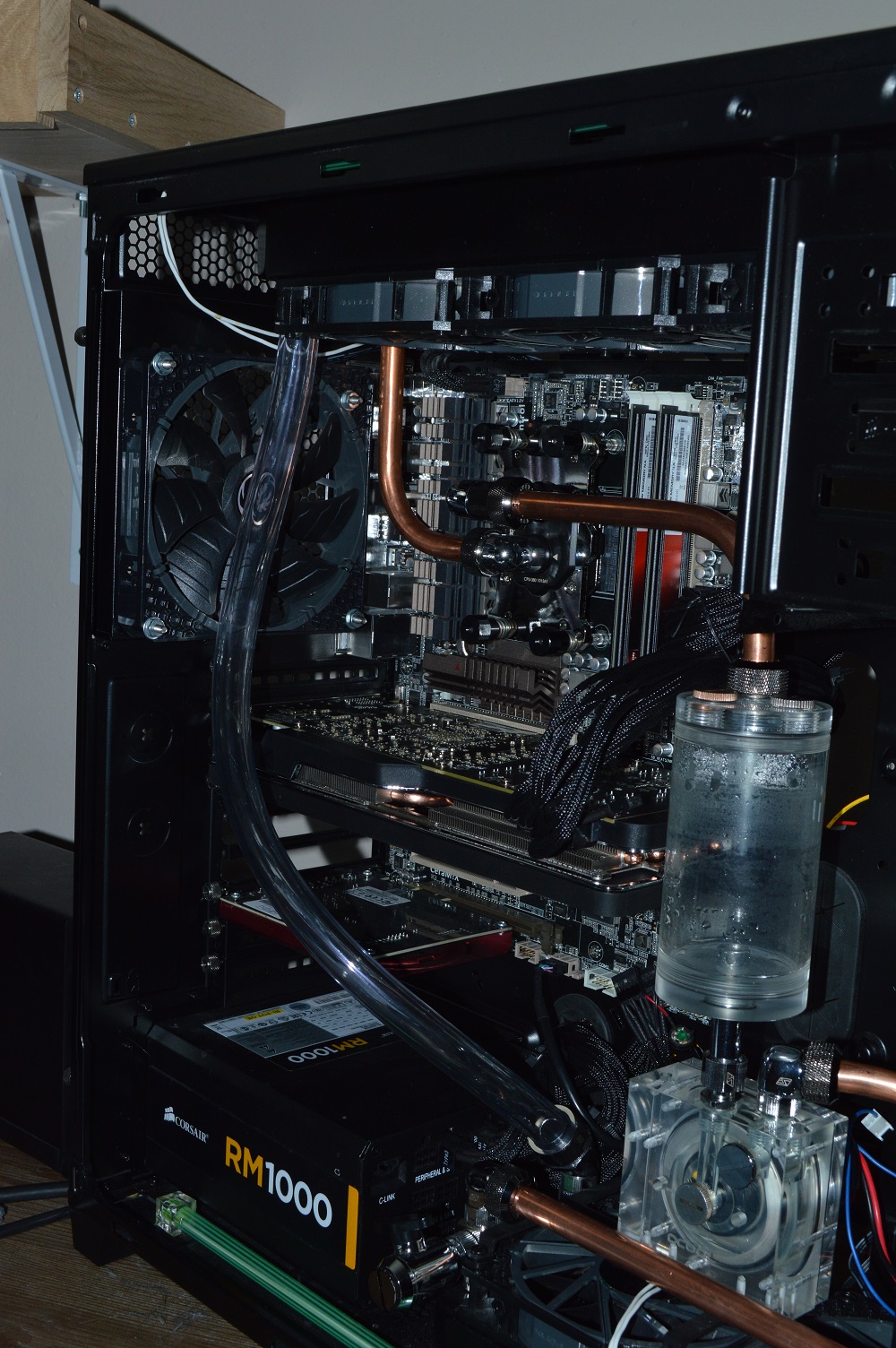
So that’s how she ran the system for two weeks. In the mean time, I looked around at blocks to decide which direction to go. In the end, going on an in-depth analysis I read online, I went with the AquaComputer KryoGraphics block with the backplate. The analysis showed the card to be the best overall block for the R9 290X. It tested to within 1C of the top performing block for GPU temperatures, which was Swiftech’s Komodo block, but the cooling of the VRMs with the backplate topped the list by a significant margin.
I ordered the block through Performance-PCs — with the recent FrozenCPU hiatus, they were the only stateside distributor. And they had one backplate and two of the blocks in stock when I ordered. The only other option would’ve been ordering directly from the manufacturer. It would’ve been a similar price, but would’ve included a nearly 2-week wait time before shipping. FrozenCPU had the block, but not the passive backplate.
The one thing I found rather intriguing is how the block is shipped vacuum packed:
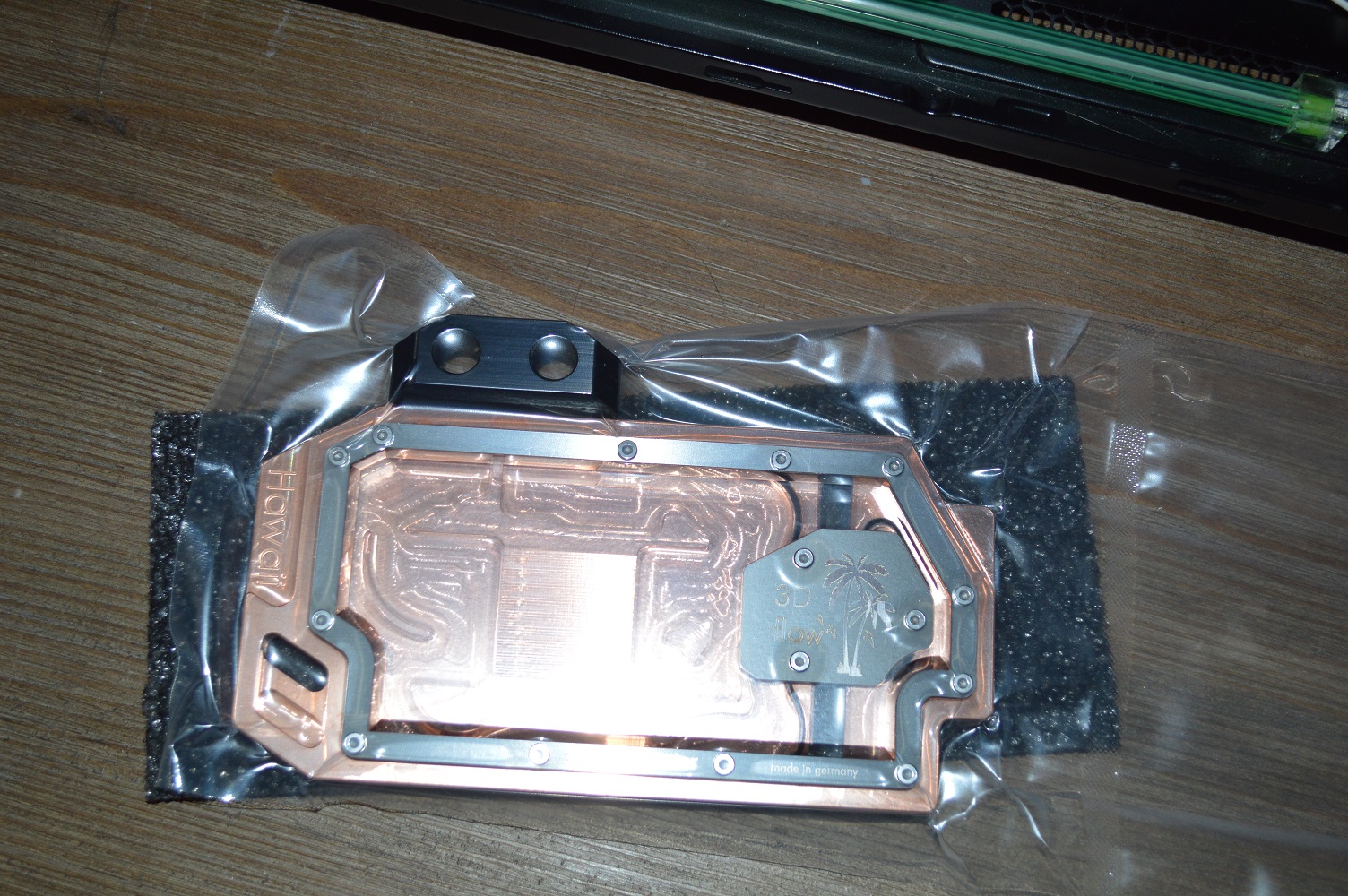
Unfortunately due to the washout from the flash, the full beauty of this block can’t really be made out, and I forgot to take pictures of the card with the block installed. The promotional picture on Aquacomputer’s site does it more justice anyway (see below). It’s a great looking block, and it was a relative breeze to install — but then I’ve had a bit of practice doing that. It’s also the only block I know of that has you use thermal compound on the memory chips instead of thermal pads. The backplate was also easy to install.
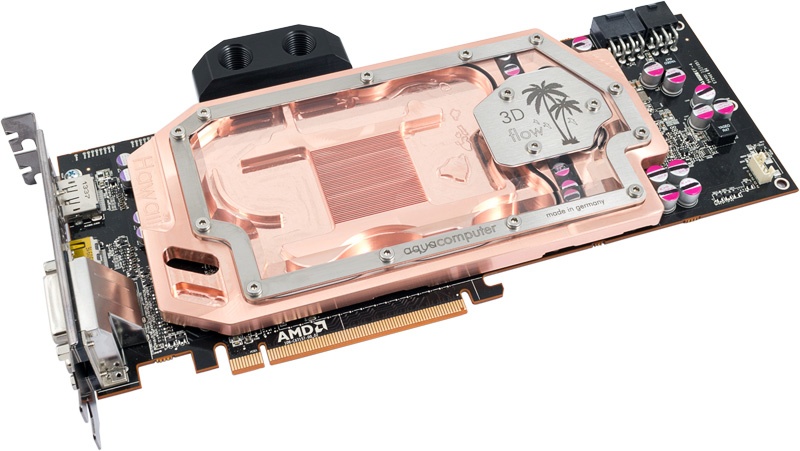
Yes, that’s the Hawaii islands cut into the copper cold plate. It’s manufacturing detail that’s mostly wasted as well given that, in most builds, that face of the block will be toward the bottom of the case and not in ready sight.
Anyway, once I got the card installed, it was a matter of doing the rest of the loop.
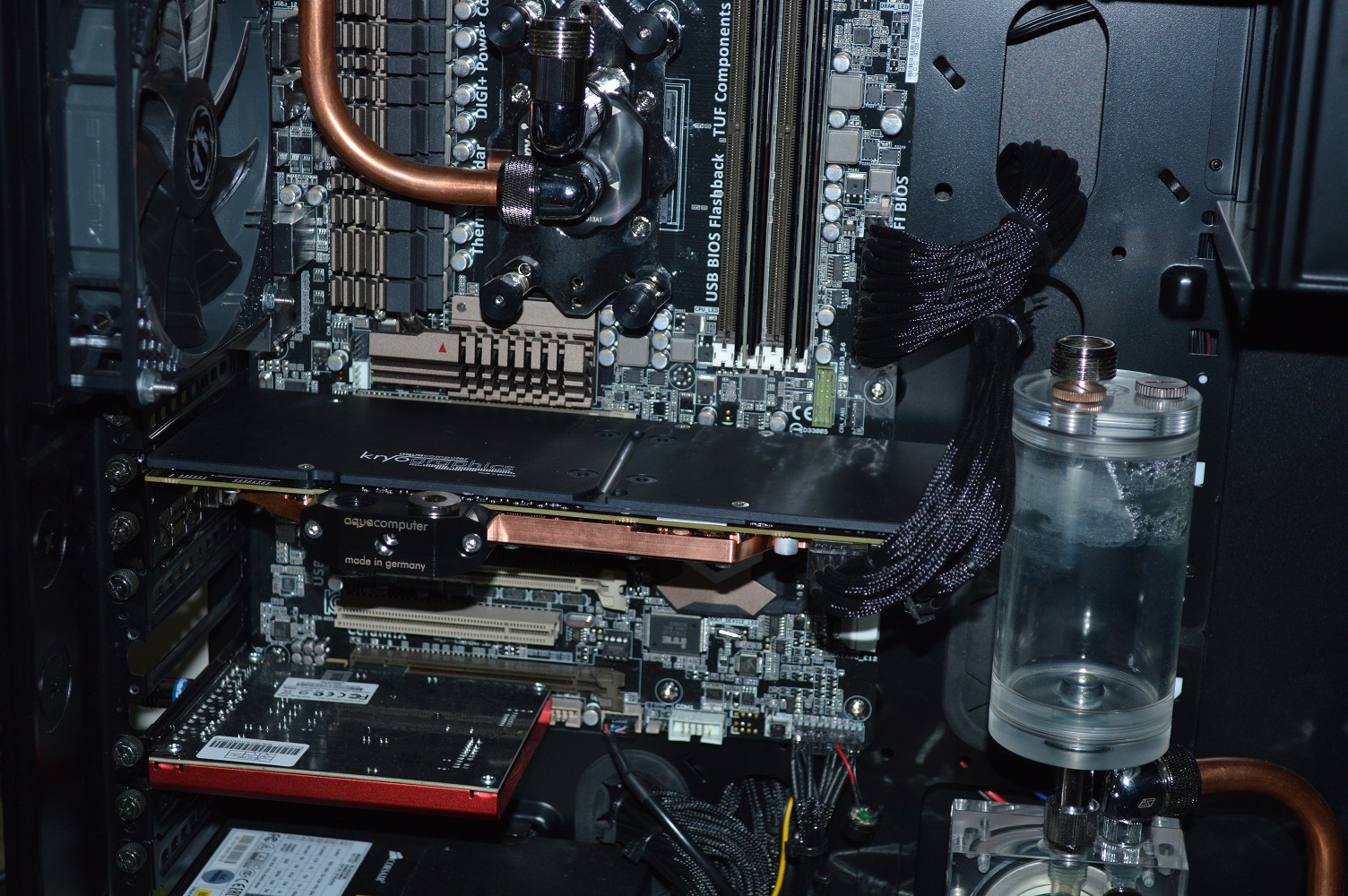
This wasn’t as easy as it sounds, merely because I kept overthinking some things.
First, in noticing how the pump and reservoir were barely held down with how I had them mounted, I thought the better idea would be to have it straddle two UN Z2 brackets in the middle of both of the 120mm fans on the bottom radiator. Only problem is having the Z2 bracket on the fan closest — actually directly underneath the front radiator — interfered with the front radiator and meant I couldn’t mount the front radiator. So scratch that idea.
So I thought I needed to separate the pump and reservoir and started exploring that idea. That introduced quite a few complications into the equation, and it wasn’t until my back was screaming at me from working on this all day that I realized something I should have hours earlier: removing the stock cooler shortened the graphics card by up to an inch. This meant that I could keep the pump and reservoir mounted to the bracket and held a bit more securely to it.
So I tried that idea — and it worked! — and went to bed, after having my wife try to get as many kinks out of my back as possible. I saved finishing the tubing and getting it filled for a leak test till the next day.
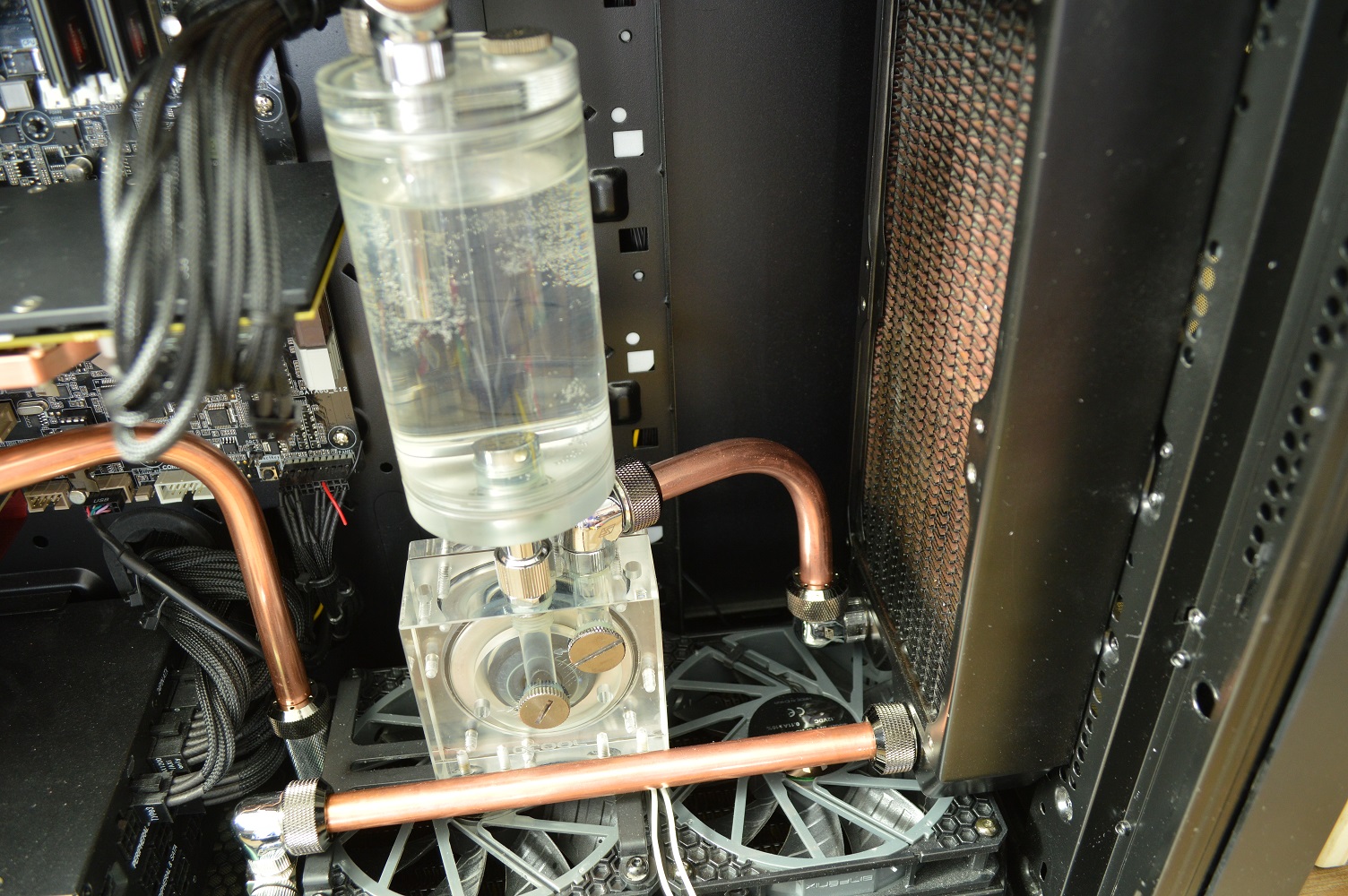
Looking at that picture, you can probably see how it’s mounted at the edge of the bracket. It’s very similar to how I had it mounted in the initial Absinthe build, only on the opposite side of the bracket. It’s sturdy, held in place by two M4 bolts from underneath, and the tubing running from the CPU back to the top of the reservoir also helps keep it in place.
You can see off to the left of the pump the new run from the bottom radiator to the graphics card — just one giant 90-degree bent piece of copper tubing. And I went with another 45-degree bend to go from the graphics card to the top radiator.

The windowed lid on the block makes it very easy to tell when there are large bubbles still trapped in the block. I was tilting the case to all kinds of different extremes to get the largest bubbles out of the block as I wanted those gone before I powered on the system.
And initial performance numbers from the block are certainly quite pleasing — ambient temperature was about 20C:
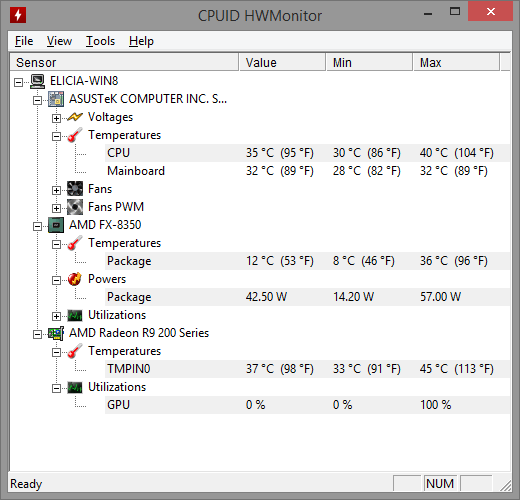
It topped out at 45C after running three cycles through Unigine Heaven. The stock cooler would top out in the lower 70s. On cold boot, it idled in the lower 30s — not unexpected given the hotter profile for the card. I expect temperatures may improve as the last of the air works its way out of the blocks and radiators, but it won’t be a significant improvement.